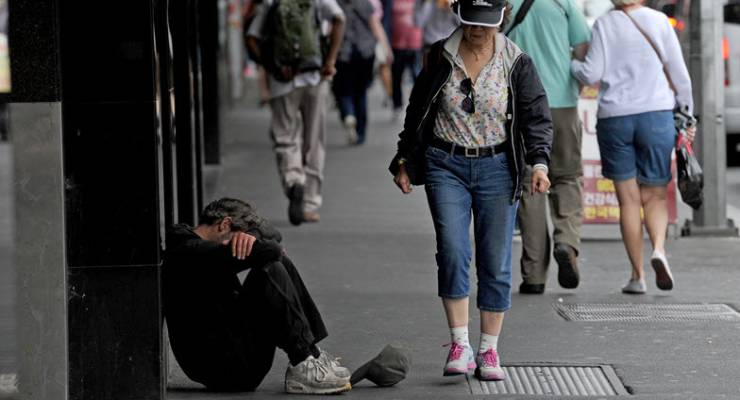
This is part two in a three-part series on mental health services. Read part one here.
Denise* is 75 and constantly worries about her son James* who has schizophrenia and often experiences homelessness.
It’s a constant battle to get James the services he desperately needs. Denise lives interstate and spends countless hours on the phone trying to arrange care for him.
“I get the ball rolling but by then it’s too late, he just gets more and more ill,” she tells Inq. She said the similarities between her son and David Harris, who died when National Disability Insurance Scheme and mental health services were cut off, are striking.
“James’ life is exactly the same … You could have been talking about him,” she says.
James, like Todd Malcomson, who also suffers mental health crises, has to wait until he is seriously ill to get help. Between stays he’s often discharged to no support network and limited services until he becomes unwell enough again to be hospitalised.
James and Malcomson are among 690,000 Australians living with a severe mental illness and bouncing between hospitals and, often, homelessness.
Missing in the middle are community mental health services. These reduce hospital visits and connect clients with mental, physical and social support networks.
Many have lost funding and closed since the National Disability Insurance Scheme (NDIS) came into being. (It, unlike community mental health services, doesn’t offer treatment.)
The remaining few run on shoestring budgets through local health districts.
Discharged to nothing
James, who has a sweet temperament and cares for stray animals, has spent the past decade drifting in and out of emergency wards. Just once has he been referred to a community mental health service. Occasionally he gets to see a psychiatrist. Often his medication is court-mandated.
There’s little communication between mental health services across states and, despite a note in his file to inform Denise of James’ discharge, hospitals often don’t.
Once, despite the hospital being in daily contact with Denise, James was discharged when in the grips of a psychosis.
“He slipped through the net and was missing … I honestly didn’t know where he was, which was distressing,” she says.
It took police days to find him, curled up in a cave and soaking wet.
“Nobody let me know he was discharged — it happens all the time,” Denise says.
A severe shortage
There are just 132 state- and territory-run community mental health services in Australia. In 2017-18, they treated 435,000 people. More than a third were discharged in under 14 days.
Community Mental Health Australia’s chief executive Bill Gye told Inq the services had been almost wiped out since the NDIS arrived.
“Community-managed organisations and NGOs, they’re the ones that have taken a beating in the last four to five years,” he says. “[Before NDIS] it was a much healthier environment.”
There’s no data on how many community mental health services have closed. Many have merged with other services, others have reduced specialised services and many, Gye said, had to casualise their workforce and hire less skilled staff.
“[Community supports] need to be sufficient so people connect with others, maintain relationships, look after themselves, find employment and function in the world,” he says.
“There’s a large group who either have nothing, or they wait until they end up in hospital in an acute crisis … The stay there is short because the hospital’s key performance indicator is to get people up on their feet, then back into the same circumstances.”
A home, a budget, and high hopes
After two years of drifting in and out of emergency departments with sporadic and limited access to a psychologist, last year James was admitted to a state-funded community mental health service. It was the first time in a long time he had a stable home, a budget, and aspirations to study.
“He became almost like how he was in the early years before he became ill,” Denise says. His love of sport returned and he became devoted to a little stray cat he named Isobel.
Six months later funding for the service had been cut.
“It’s been bad ever since,” Denise says. “I’m just trying to keep him going. I worry about him when I’m no longer here.”
The gap in care
About 690,000 people in Australia have a severe mental illness. Just 21,700 receive psycho-social support under the NDIS. Up to 91% will have to rely on non-NDIS community mental health services.
Jennifer Smith-Merry, the director of Sydney University’s Centre for Disability Research and Policy, told Inq the transition from Commonwealth-funded psycho-social support services to the NDIS had not gone as planned.
“The assumption was people getting support from [community mental health services] would then go to the NDIS, but the reality is there hasn’t been anything like the expected numbers,” she says.
Fewer than half of those who had been in community programs applied for the NDIS, and almost a third were rejected. Those who didn’t apply feared the application process or had too poor mental health to do so.
The NDIS also isn’t designed to provide services for crises.
“The NDIS is meant to provide support for functional needs … It deals very poorly with crises because it’s a slow-moving beast,” Smith-Merry says.
“When people have been acutely unwell the other crisis services need to be implemented through support from community mental health teams.”








This NDIS sounds like an instrument created by the govt just to cut funding at a moments notice.
“Those who didn’t apply feared the application process or had too poor mental health to do so.”
A friend of mine who struggles with a few issues showed me some of these form he was required to fill out to get the ball rolling. Albert Einstein could n’t fill these things out properly let alone somebody who finds themselves falling through the cracks and not in a good place.
To the govt making it too easy is the last thing they want. Enter NDIS, the Clayton’s mental health care system when you are not having a mental health care system.
Nothing new here. It has been going on since 1982, when my sister was evicted from the mental hospital and told to go to Sydney and the Sydney City Mission would look after her. The land was then sold. Mental health services are still hopeless and in regional areas worse still. Bleeding hearts with all care and no responsibility for the consequences . Christ knows how many died or wound up in prison. No one really counted.
ogbo…I was one of those MRN’s of the 80’s/90’s ..Yes there were ‘bleeding hearts’ as part of our well trained/learning fields ( some knowing quite well the brutality of the 50’s/60’s/70’s)..There were mistakes made ..the biggest being political…But oh,boy ,did it then get viciously callous as the neo-liberal yrs rolled on ..Those same viciously callous politics that helped the Aussie/Ozzie battlers house prices go through the roof, amongst other ‘advantageous’ things ..The societal zero sum game of getting ahead from the harm and neglect done to others..The medical field/s can be fraught with mistakes & harm ,most usually,(hopefully) not deliberate .But the politics, you know, those things that people have a small hand in, in voting & lobbying ,etc…Yes ,the vicious, callous politics ,that came to be the dominant paradigm of our civil society….that really did the damage, helped produce the damage, upon damage, to the already damaged..
The problem is . . political, fiscal and ideological. Current LNP Govt’s lack of empathy towards those they see as mendicant citizenry ie aged, disabled – both physical/mental; in fact illustrate how individuals identified as a cost upon public purse colours and translates accordingly when communicated by Minister to Senior Public Servant. Robodebt merely last hurdle erected to illustrate priorities?
Australia is growing-up. Citizens are either an asset, or liability. Those at the “top” exerting much greater downward weight onto the shoulders “of those below.”
Not that the LNP will ever deliver adequate mental health care, but this problem is older than both the current string of LNP federal governments and the NDIS. Sadly the case with most care. Getting what you are entitled to can be like pulling teeth and what you get is often inadequate.
The balls in the state and federal government’s court but I don’t think you should let historical governments off the hook. It shouldn’t be a problem still.
The litmus test of any nation is how they treat the disadvantaged. Mental health care should be a top priority, not something akin to a lick-spittle. Obviously no mileage for the votes and If it’s a money and budget issue then just print it. A bit of love occasionally would go astray.
‘“The assumption was people getting support from [community mental health services] would then go to the NDIS, but the reality is there hasn’t been anything like the expected numbers,” she says. ‘
It certainly was the assumption. Funding for the services delivered to both individuals and carers under previous community mental health arrangements was rolled into NDIS funding. There is no doubt accessing appropriate CMH funding through the NDIS hasn’t gone as planned, but you’d have to wonder where all the money went.